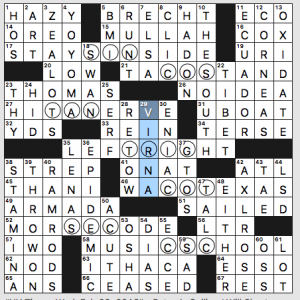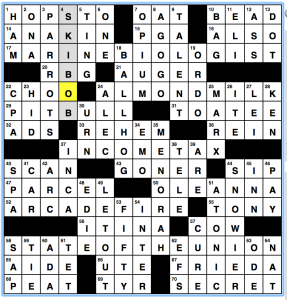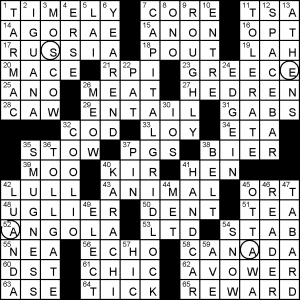Peter A. Collins’s New York Times crossword—Jenni’s write-up
You know all those trigonometry abbreviations that show up in crosswords and make you roll your eyes? OK, maybe that’s just me. They’re the theme of this puzzle (with circles. I think you all know how I feel about circles in my puzzles).

NYT 2/28, solution grid
- 17a [Is a recluse] is STAYS INSIDE. (sine). You don’t have to stay inside to be a recluse. You could live in a remote area and go outside and still not see anyone.
- 21a [Shell station?] is TACO STAND (cosine). OK, that one’s cute.
- 27a [Land close to home] gave me a little trouble, because I read “land” as a noun. It’s a verb; the answer is HIT A NERVE. (tangent).
- 35a [When repeated, marching orders?] is a revealer of sorts: LEFT RIGHT includes TRIG.
- 46a [City on the Brazos River] is WACO TEXAS. (cotangent)
- 52a [Where S is …] also gave me pause. The answer is MORSE CODE. (secant)
- 58a [Place where students are graded on a scale?] is a MUSIC SCHOOL. (cosecant)
So there you have it. Not my favorite theme.
A few other things:
- I disliked this puzzle before I even got to theme answers because of 5d [Fat stat]. The answer is BMI. We’ll ignore for the moment the evidence that suggests that BMI is wildly overused and overinterpreted, and focus on the fact that everyone has a BMI. Fat people, thin people, medium-sized people, tall people, short people, whatever. We all have a body mass index because we all have a body and all bodies have mass. I don’t object to the word “fat.” It’s a descriptor, not an insult. I do object to the idea that only fat bodies are measured. And yes, I am aware that this was simply an attempt to be cute and amusing for what would otherwise be a boring answer. It’s still a terrible clue.
- 8d [___ Stic (ballpoint pen)] is CLIC. If you haven’t yet read the reviews for Bic’s less well-thought-out product, the Bic For Her Retractable Ball Pen, you are in for a treat. There’s a joke somewhere in “retractable balls” but I’m too tired to think of it.
- 28d [Haul back to the auto pound] is RETOW. Just say no to RETOW and other roll-your-own words. You can’t declare that something is a word by sticking a prefix on another word. That’s not how it works.
- 54d [Mayo parts?] completely stumped me. I finished the puzzle and I knew it was correct and I stared at it for quite a while, trying to figure out how DIAS connected to either the condiment or the Irish county. The light finally dawned: it’s Spanish for the month of May, which is made up of days. Phew.
- 47d [Anti-rash powder] is TALC, which has been associated with ovarian cancer. Don’t use it. If you need something, try cornstarch.
What I didn’t know before I did this puzzle: that VIRNA Lisi existed.
Daniel Hamm’s Wall Street Journal crossword, “Golden Boy” — Jim’s review
 The Oscars are this weekend, so here we have an OSCAR-themed puzzle. The letter string OSCAR is hidden inside made-up phrases (because you’re not going to find enough real phrases that can do the job).
The Oscars are this weekend, so here we have an OSCAR-themed puzzle. The letter string OSCAR is hidden inside made-up phrases (because you’re not going to find enough real phrases that can do the job).
- 17a [Eerily white figure in a field?] ALBINO SCARECROW
- 26a [Vehicles pulled by thick-skinned beasts?] RHINOCEROS CARTS
- 40a [Still life featuring pears?] BOSC ARRANGEMENT
- 49a [Some Met run-throughs?] TOSCA REHEARSALS
 I don’t get a lot of thrill out of hidden word themes, but they do the job of giving the solver an added hint to thorny theme entries. In this case, there are a couple of elegant features to this set as well. First, each entry is a grid-spanner. Second, with a letter string that’s five letters long, there are four possible ways to split them across two words. Each method is used once and in order as you proceed down the grid. Nice.
I don’t get a lot of thrill out of hidden word themes, but they do the job of giving the solver an added hint to thorny theme entries. In this case, there are a couple of elegant features to this set as well. First, each entry is a grid-spanner. Second, with a letter string that’s five letters long, there are four possible ways to split them across two words. Each method is used once and in order as you proceed down the grid. Nice.
 As is often the case in WSJ grids, many clues are theme-adjacent by referring to films in general. Two of them refer to this year’s OSCAR contenders: THREE gets the clue [Number of billboards outside Ebbing, Missouri], and YOUR is the answer to [“Call Me by ___ Name”].
As is often the case in WSJ grids, many clues are theme-adjacent by referring to films in general. Two of them refer to this year’s OSCAR contenders: THREE gets the clue [Number of billboards outside Ebbing, Missouri], and YOUR is the answer to [“Call Me by ___ Name”].
Favorite fill: RAISINET, VAMOOSES, LA CASA, SHLOMO, CLICHE, and DE CARLO (39d, [Yvonne of “The Munsters”]). I don’t know that I would ever recognize her without her Lily Munster make-up, but see the photo of how she looked in the OSCAR-nominated The Ten Commandments.
 And now, for no reason, how many of the fictional Oscars in this post can you name? I myself only knew three of them.
And now, for no reason, how many of the fictional Oscars in this post can you name? I myself only knew three of them.
Aimee Lucido’s AVCX, “Cross-Country” — Ben’s Review
 It’s suddenly the end of February already! How did that happen? However we got here, it’s Wednesday, so that means there’s a new AVCX puzzle. Today’s is from Aimee Lucido and has a 2.5/5 on the difficulty scale. Groking the theme on this one took me a few minutes, since there were no shaded/circled squares in the grip to point out what’s going on:
It’s suddenly the end of February already! How did that happen? However we got here, it’s Wednesday, so that means there’s a new AVCX puzzle. Today’s is from Aimee Lucido and has a 2.5/5 on the difficulty scale. Groking the theme on this one took me a few minutes, since there were no shaded/circled squares in the grip to point out what’s going on:
- 17A: U.S. scientist who traverses the country to study harbor seals, river otters, and cattle? — MARINE BIOLOGIST
- 24A: U.S. dairy product that goes equally well with pecan pie, hot salami sandwiches, and knoephla? — ALMOND MILK
- 37A:U.S. levy on automobile race winnings, weed, and blueberries? — INCOME TAX
- 52A: U.S. forest event that starts in the Ozarks, spreads to Death Valley, and then … burns down a bunch of corporate tax havens? — ARCADE FIRE
- 58A: Annual speech, and an alternate title for this puzzle — STATE OF THE UNION
The execution of this theme left me a little confused. Finding some way (circled squares/shaded squares/etc.) to indicate that the first words of each of the non-58A theme answers can be spelled out using US State Abbreviations would have made this feel much closer to a 2.5/5. Another thing that bugged me was the clue for 52A – when all the other clues for MARINE BIOLOGIST, ALMOND MILK, and INCOME TAX are straight definitions, not doing that for ARCADE FIRE seems off. I tried googling every combo of “forest event”, “Ozarks”, “Death Valley”, etc, and I don’t get anything resembling info on this, just a bunch of results for the indie rock band that are notable enough at this point that they should have been the clue.
Other solving notes:
- I was pleasantly surprised that it was Notorious RBG instead of the standard Notorious BIG, but boy did that need to be clued in a parenthetical that nudged me that way – the RBG internet meme isn’t nearly as widespread as it needs to be for that to be an auto-connection in my brain
- 50A‘s clue for OLEANNA, “Mamet play that would have been written very differently by a woman” also felt a little underclued to me – I’d argue that any Mamet play would be written very differently by a woman.
- As a Minnesotan, I am very familiar with snowmobiles, but I’ve never heard of SKIBOBs
- You are not a SAP if you’re the “Sort who cries during ‘Coco'”. You are a person with a functioning heart.
3/5 stars.
Paul Coulter’s LA Times crossword – Gareth’s write-up

LA Times
180228
I figured the theme out at MOSCOW/RUSSIA, with the circle making it stick out like a sore thumb. Duma – Russia is a specific link, whereas LUANDA/ANGOLA and OTTAWA/CANADA are more broadly clued. Hellenic in the clue gave ATHENS/GREECE away. CAPITALGRIDLOCK is not a phrase I’ve heard of; in quotes, it gets 1,540 hits, two of the top 3 of which are about traffic in Jerusalem and Djakarta respectively… I’m not buying that that’s a legit phrase at this point.
Intersecting theme answers always makes the surrounding fill super tough to fill, and all four corners are “bigger” than usual to fit the 6×6 intersecting themers. The scowl-o-metre went into overdrive in the very first corner with AGORAE/LAI/ERSE and I couldn’t get it to start working again…
Gareth


Why on earth isn’t TRIG included as a 4-letter revealer instead of circled within a 9-letter entry in the middle? There’s so much woeful fill here. ONAT THANI ESSO HOS LENAS RETOW VIRNA CLIC ENIAC ECCE HADON GTOS OXIDATE TAE OSS? No, no, no. Seven theme entries is too much, apparently, because this grid is stuffed with muck.
Especially because it awkwardly splits tangent and cotangent.
I don’t understand that. How are they split awkwardly?
(I agree the fill suffered from the constraints of the theme, but I am impressed in the arrangement: three primary functions, TRIG, three inverse functions in symmetrical order with their reciprocal functions.)
Oops, that’s my fault. It’s been a long time since I studied trig and I was thinking that sine-cosine, tangent-cotangent, secant-cosecant were pairs that went together, but of course, you’re right that the sets are sin-cos-tan and then the inverses. I still think that running TRIG across the middle wasn’t really needed. If you’re going to have a revealer have it be special. Like LOVE TRIANGLES clued as “Rom-com scenarios, or what someone would have to do in order to possibly appreciate this theme.”
I don’t get that either, and it really confused me. I started wondering if there was a trigonometric function that shortened to TRIG I had never heard of (which would be really strange considering I have an advanced degree in mathematics). But then I realized it’s just an awkward revealer that indeed mucks up the fill.
Amy, this theme was my debut in the Chronicle of Higher Education last February.
http://crosswordfiend.com/2017/02/16/friday-february-17-2017/
I did use TRIG as a reveal and think it improved the fill.
Also, I ruled out using TACO STAND as a themer because it contains two
trig abbr. (COS and TAN).
Roger (retired math teacher, Chicago area)
Just for the record, my puzzle was accepted a year-and-a-half ago — long before Roger’s CHE ran. I don’t want you to think I’m one of those kind of guys. Without the TRIG in the middle, Roger’s grid could definitely breathe better.
I loved Will and Joel’s clue for THE SOUTH [Lee side]. Mine was [Gray area?]
i don’t mind that the NYT theme has been done before. however, i’m a firm believer that if you’re repeating past themes, you damn well better have a reason for doing it, and/or you should do it a lot better. this puzzle fails on both counts, as far as i’m concerned. especially the second: that fill. ugh.
that said, i will give it this: the top half has the most common trig functions: sin, cos, tan. the bottom half has the reciprocals, in reverse order: 1/tan, 1/cos, 1/sin. i doubt most people will pick up on that, but that’s something to be admired, and a lesson re: logical / elegant theme ordering to new(er) constructors.
Or it’s a stunt puzzle with terrible fill. I didn’t notice the order, and I went further in math than most non-mathy folks, plus I’m not your average solver. Lesson to new constructors: don’t do this.
NYT: I interpreted “fat” in the BMI clue differently than Jenni. I didn’t read it as an adjective describing the person whose BMI is being measured; I read it as an attributive noun that describes the stat. That is to say, BMI measures the fat on people (regardless of what size they are), and hence it is a “fat stat”. So, effectively fat is being used a cutesy synonym for mass, which we all have.
What do other people think?
I am in agreement re BMI – the Body Mass Index is a measure of body fat. You can have a low or high BMI, but what it is measuring is fat.
That’s not right though – all BMI takes into account is height and weight. The distribution of your weight between fat, muscle, and other tissue isn’t accounted for at all.
I absolutely agree. I was going to post about that but you beat me to it.
Exactly. That was how I read it too.
perhaps the takeaway here is that it is not the right word/concept to get cutesy about?
If that was the line of reasoning, then it’s just flat-out wrong. BMI tells you nothing about body fat percentage. It is calculated using height and weight only. Two people can have widely divergent body fat percentages and have the same BMI.
Far be it from me to point out that four men just undertook to explain medical information to a woman who happens to be an MD.
Sorry, e. a., that wasn’t aimed at you.
Jenni, I didn’t undertake to explain medical information to anybody. My point was about the ambiguity of the word “fat.” I interpreted it differently you. (I was thinking of body fat; a fat person didn’t even enter my mind.)
I was taking it as a given that BMI measures body fat in some way. If you say it doesn’t, then I’m wrong, and I apologize.
You said “That is to say, BMI measures the fat on people (regardless of what size they are), and hence it is a “fat stat”.” That sounds lot like explaining medical information.
And you are wrong – which apparently didn’t cross your mind as a possibility when you saw that I read the clue differently than you did.
It didn’t cross my mind I was wrong because I didn’t know right and wrong were even in the equation until after reading the follow-up comments by you and others. (The quote was me trying to illustrate my interpretation, not me proffering medical info, of which I have little.)
Your interpretation of the clue was different than mine, and I was curious what other people thought. That’s it. I certainly never meant for things to get turned sideways. Stupid clue.
hm … no need for that attitude, Jenni – and what does gender have to do with it?
My answer was based on the definition offered by the National Heart, Lung and Blood Institute –
“Body mass index (BMI) is a measure of body fat based on height and weight that applies to adult men and women.”
I am happy to accept that I am incorrect and defer to your MD.
your attitude comment is out of line my dude
Well, I don’t want to argue the point here. I come here for word play. If I’m out of line, then I apologize – I was referring to the “Four men just undertook to explain … to a woman”. I was a little offended by that. No more from me on the subject.
What did I miss? Did I get “four” wrong? Did I mis-gender someone? I think not.
Here’s the ur-text on the subject: https://www.guernicamag.com/rebecca-solnit-men-explain-things-to-me/
“BMI tells you nothing about body fat percentage.”
That seems a bit strong. Yes, an athlete with my same height and weight, who thus shares my BMI, will have very different body fat percentage. But if I diet and lose weight, my decreasing BMI is largely about a lowered fat percentage. (Of course, I likely have lost muscle mass too so body fat is not the entire story, but it’s a large part of it. It’s why my MD bothers to chart my BMI.)
The BMI thresholds for “underweight,” “normal,” “overweight,” “obese,” etc. imply an underlying assumption that the metric is body fat for an “average” person. The “overweight” athlete who’s really not overweight at all, just unusually muscular, is considered an outlier.
BMI has well known limitations, but to insist it’s not a (flawed) metric for body fat seems to deny its stated purpose.
tl;dr: I know more than people who actually work in the field. – Martin.
It’s precisely because of your credentials that I’d like to understand where you say my argument goes wrong. I’m curious about it and would greatly appreciate more than an ad hominem response.
Sigh. Google exists for a reason. I am not Google. Also, you did not ask. You made a statement contradicting the explanation I already gave and said I was “deny{ing} its stated purpose.” There isn’t a single question mark in your comment. “Hey, Jenni, that’s not how I understood it. Can you explain?” That’s a question.
BMI takes into account only weight and height. To measure body fat, you need to look at a variety of other factors, including (but not limited t0) distribution of tissue and metabolic activity. Truly accurate body fat measurements can only be done in a metabolic lab. There are a number of ways to estimate body fat without that equipment. I don’t know which is most accurate because it’s not a measurement that’s useful to me.
There is a loose relationship between BMI and body fat percentage in any given population but it varies based on genetics. That relationship is different for Asians and US whites, for example, and it’s different for US whites and African-Americans.
Does that meet your needs? Or was there some other request hidden in your statement?
Thanks. No hidden request. (And I did a lot of googling before my first post.) But I guess I still don’t understand why BMI is a thing. I get that it’s not an accurate way of assessing body fat percentage, but my googling seems to indicate it only exists as a proxy for body fat, although it needs to be interpreted carefully for build type (as determined by genetics and lifestyle).
So I guess my question boils down to: in your opinion, is BMI a useless metric or, if not, what does it tell us?
I wouldn’t say it’s entirely useless. I do think, as I alluded to in the post, that it’s wildly over-interpreted and treated as if it’s far more meaningful than it really is. It’s clear that on balance in a large population, there are correlates between BMI and health, with detrimental effects to both a very low BMI and a high BMI. The correlation is weaker than usually presumed and very weak for the middle 50% of the bell curve. In my ideal world, it would be a starting point for a discussion and investigation of the individual patient, not a cut-and-dried determinant of diagnosis.
Thanks again.
“BMI tells you nothing about body fat percentage. It is calculated using height and weight only.”
Bingo. I hated this clue too.
You’d think the fact that it’s a Body Mass Index and not a Body Fat Index would be enough to indicate that it’s not a body fat index… because it’s a body mass index.
I’m with Doc Levy on this one.
Maybe.
Perhaps “Body fat stat” would have been a better clue, if you want to keep the cutesy rhyme. It’s obvious what you mean by “fat” in that clue.
Maybe what? Maybe I’m right? Seriously?
ETA: Sorry. Just saw your apology above. Accepted.
Wow, every time I visit this site after a long hiatus, I see irritating stuff.
Jenni, you need to relax. Seriously. Relax.
It’s okay for people to disagree with you. It is. And it’s okay if those people are men. It really is.
Now, I’m NOT a man, and I AM a MD, and I don’t necessarily agree with you. Can you find some way to be overly condescending and insulting with that information, too?
Reeeeelax.
Well, I could, but you’ve got condescension covered, so there’s no reason.
Wow. Just … wow. Cindy, that comment is uncalled for.
AV Club & WSJ: It’s about 10am eastern time, and I see that these two puzzles are both rated less than a 2. I’ve never before seen a puzzle rated under 2, much less two on the same day. While I haven’t looked at the AV Club puzzle, I solved the WSJ puzzle and found it to be my favorite non-Friday WSJ puzzle in some time. I love the image of an albino scarecrow driving his rhinoceros cart to MOMA to drop off his bosc arrangement before heading over to the MET to catch the Tosca rehearsal. Maybe that’s just me. I say a puzzle with four clever themers spanning the entire grid with virtually no drekky fill deserves at least 4 stars. Anyway, I hope there are no shenanigans going on today.
I also thought the rating was a bit harsh. I don’t generally like this kind of “current events” theme, nor do I pay attention to the Oscars, so for me the general puzzle was a “meh”, but I thought the theme entries were clever enough. I would have loved to have seen some kind of Felix Unger reference in there … (“Oscar, Oscar, Oscar!”), but that would be a different puzzle, I guess.
I stared at “HIT A NERVE” and just couldn’t see it right. (“What’s an ‘ERVE’?”) Partly because “Land Close To Home” is not so familiar to me. “Hit” close to home, yes – but that wouldn’t work here. I couldn’t break away from nearby airports or neighboring countries.
My father-in-law used to sputter incessantly when theme clues were crossed with obscure trivia. (“Margaret Farrar would never let that pass!”)
This is sort of like that – though I realize it’s not a theme clue. Never saw “How To Murder Your Wife”, never heard of Virna Lisi. Sputter, sputter.
The WSJ is indeed elegantly constructed and masterfully clued. I note, though, that a hide-a-word theme in which there is no real-world base phrase *and* the answers are completely invented is… well, it’s not my favorite.
I did enjoy the mathy theme of the NYT, and the real-world base phrases thereout. (I did scowl at the BMI clue as well.)
This is the second appearance of OXIDATE in recent puzzles, and I am going to make the same objection that I made before. Yes, it’s a word you can find on various internet dictionaries as a synonym for OXIDIZE, but (a) it’s not listed in MW11, my go-to everyday dictionary, (b) it’s not a word that I can imagine an actual chemist using, and (c) this site (FWIW) lists it as ‘obsolete.’
It bothers me that the NYT puzzle constantly has a tin ear when it comes to science. Or maybe I’m oversensitive. You decide.
Yup, I googled oxidize v oxidate yesterday because I thought maybe my chem knowledge was subpar (I have two C-‘s on my transcript that want to make that point), but saw that it was just an archaic that for some reason has been in recent puzzles. I could barely pass gen chem, and still think that NYT has a tin ear for science.
Am I the only one who has never seen “csc” before? We always used “cosec”, both at high school and university level?
Same for me — it was always cosec. I have a feeling that CSC became the norm in Basic and Fortran sometime in the 70s, and maybe it has spread into wider use from there.
At some point, it also became standard to do away with sec, cosec, and tan, and replace with sin-1 etc.
[edit: that was supposed to be a superscripted ‘-1’ but evidently that bit of html doesn’t work here]
[second edit: I’m wrong anyway — sin**1 is inverse sine or arcsine, a different thing!]
Or perhaps CSC is just an instance of the rule that everything must be a TLA.
In my studies, sin^-1 replaced arcsin, not csc/cosec. I always hated that notation, because it looks like you are raising sin to the -1 power, making it equal to cosec!
I like the hyperbolics, cosh, sinh and tanh. They’re pronounced “cosh,” “cinch” and “tanch,” and you sound drunk when you say them.
I’ve taught numerous math classes at the college level, and I’ve only ever seen the three-letter abbreviations used in any modern textbook.
Well, my schooldays were a long time ago. And in England.
Those pen reviews are fantastic, thanks Jenni for the laughs!
Yes. Still laughing.
I do not know if this helps the BMI discussion. My youngest son is a high school freshman. He tried out for the wrestling team and would normally have been wrestling in the 105 lb. class. Except that he wasn’t allowed to without a special doctor’s permission because his body fat is 4%. You need special permission in Arizona if your body fat is less than 7%. I think this was caused by the fact that he gained 9 inches in height this year from a tiny 4’7″ to a more normal for his age 5’4″. He has six pack abs and eats normally, but I still had to pay an extra $150 to have a doctor say he was OK.
Steve
In LAT, why were the intersecting letters circled? It’s obvious they answers intersect. I kept trying to make sense of the circled letters. Maybe I am missing something?
i was so sure it was gonna spell SEAT!
To make the theme more obvious.
I’m not really sure why Rich decided to do this. On the LA Times Crossword Corner, several people pointed out it spelled ASEA, which wasn’t my intention. It was difficult enough finding symmetric pairs and constructing the grid without trying to spell something.
I think what Ben’s missing on the AV Club crossword is that the first words are comprised of state abbreviations AND the states used are all associated with the clue itself:
MA = harbor seals + RI = river otters + NE = cattle
AL = pecan pie + MO = hot salami sandwiches + ND = knoephla
IN = auto racing + CO = marijuana + ME = blueberries
AR = Ozarks + CA = Death Valley + DE = corporations
I didn’t get any part of the theme until I’d fully solved the puzzle, but working it over gave me that extra bit. I’ll also grant that it’s sort of poorly executed as the first three sort of seem like straight definitions, though there are some inconsistencies and the clues seem curious. INCOME TAX could basically just be a straight definition. Whereas ARCADE FIRE veers pretty far from its cluing. I think it would have been much better had the clues all managed to be sort of diverting.
Oh, hey, I totally missed that! Good catch.
What I don’t understand about AVCX, is the relation of some of the states to the clues. To me, they have a strong connection in the case of AR (Ozarks), CA (Death Valley), DE (tax haven), IN (car racing), CO (weed), and ME (blueberries). But I don’t think there is a strong connection for MA RI NE and harbor seals, river otters and cattle, (cattle’s ok). My first thought for harbor seals was California.
For AL MO ND and pecan pie, hot salami sandwiches and knoephla, I googled and found the connections, although AL is certainly not the only place famous for pecan pie. It’s the state pie of Texas (silly, but true, and pecan pie is really popular here! p.s. I live in TX).
NYT 52-Across I’ve confirmed with the Powers That Be that the baseline dots are intentional, even though a Morse S would normally be represented by mid-line dots. I don’t have a problem with misleading clues, but this feels to me like lying to the solver.
“You are not a SAP if you’re the “Sort who cries during ‘Coco’”. You are a person with a functioning heart.” Totally agree!